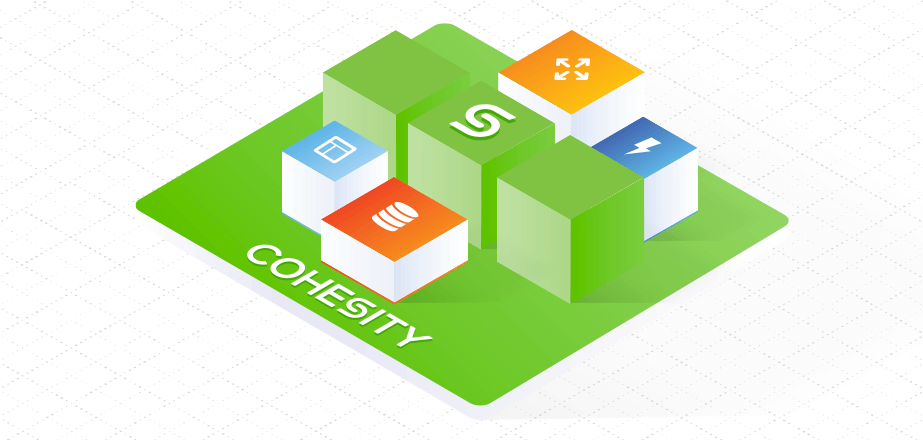This is Part II in our heterogeneity article series.
Many of us are familiar with the Iron Triangle of project management—the concept that three factors constrain the quality of a project: budget, schedule, and scope. Until Cohesity, data management was constrained by an Iron Triangle of its own, forcing organizations to make costly trade-offs between compute, capacity, and performance.
Today, we are taking another giant step to ensure our data management platform serves your organization’s many different use cases while optimizing the total cost of ownership (TCO) and meeting defined service-level agreements (SLAs). Now your IT team can have it all—data management with optimized compute, capacity, and performance—to rightsize your environment in a way that best meets your particular set of requirements.
Our Heterogeneous Approach
Heterogeneity has become an important differentiator because it provides increased flexibility when your organization wants to scale your data management system. We believe this is one of the reasons Cohesity was named a Leader in the 2020 Gartner Magic Quadrant for Data Center Backup and Recovery Solutions¹.
So how did we get here? Last May, we broke barriers and ranks with traditional legacy vendors by making it possible to run modern Cohesity data management software not only on one hardware platform but across many different types of server nodes in the same cluster. And we uniquely delivered our software on certified hardware from different vendors across form factors and generations. That way, organizations could move forward, faster toward a heterogeneous future that best addresses varied business requirements. I wrote about it in Part I of this heterogeneity article series.
Fast forward several months and now we have delivered new capabilities that allow you to rightsize all three points of the triangle. And as a result, you can consolidate workloads—backup, archival, disaster recovery (DR), files/objects, dev/test, analytics—with ease while optimizing TCO and meeting defined SLAs.
Meeting Your Business Needs
So let’s look at how this works. How does Cohesity simplify data management while maximizing flexibility? In addition to our existing general-purpose nodes, we have expanded the types of nodes you can select to build your environment, and therefore, optimize for the types of workloads that you deploy, depending on your business needs.
- Compute nodes, supported beginning with our 6.5.1 software release, supply additional processing power to your cluster to run Cohesity Marketplace applications (e.g., for anti-virus, analytics, etc.) as well as NoSQL and Hadoop data protection services. Your Cohesity cluster can now be enhanced with a compute node from Cisco, Hewlett-Packard Enterprise (HPE), Dell, or others².
- With capacity nodes, you gain storage depth, allowing you to optimize cost automatically between tiers. These are also available from a variety of providers.
- With performance nodes, including an all-flash option³, you can optimize for I/O-intensive workloads such as log analytics.
But, here’s the other big benefit we provide. Cohesity breaks down silos and brings all of these nodes together into a cohesive experience. One that allows you to expand your cluster supporting a heterogeneous or mixed-mode environment to consolidate workloads. All with mission-critical availability. That’s the secret sauce.
So you can have one modern data management solution meeting all of your organization’s requirements:
More specifically, in a single Cohesity cluster, you can combine different types of nodes from multiple vendors (Cohesity + 1) together:
| Certified Node | Description |
| Compute | Compute-only node, no storage4, to accelerate CPU or memory-intensive services. For example, select Cohesity Marketplace apps and backup and recovery of NoSQL (MongoDB, Cassandra, etc.) and Hadoop databases |
| Performance | An I/O-optimized node using faster, or soon all-flash, hardware |
| Capacity | High-capacity, low-performance node for cold data |
| General Purpose | A node with a good mix of compute, capacity, and I/O performance for most workloads |
Enjoy Maximum Flexibility at Lower TCO
Data growth and compute requirements are related, but neither should hold back nor limit the other. Your business needs flexibility in data storage capacity and compute resources to meet different SLAs. With capacity and compute nodes in a single heterogeneous cluster from Cohesity, you can scale cluster storage and compute resources independently to meet your business requirements.
And at a time when budgets are heavily scrutinized, Cohesity can lower your total data management cost of ownership by supporting different workloads cost efficiently. Unlike legacy providers where in many cases all of the nodes must be of the same make and model from the same vendor in a homogeneous cluster, Cohesity can address your different use cases with suitable node types—for example, NoSQL and Hadoop backup and recovery with a compute node, log analytics with a performance node, and automated tiering with a capacity node—in a single, heterogeneous cluster. That’s something you can take to the bank without breaking the bank!
Cohesity’s software-defined data management platform doesn’t treat your infrastructure decisions as part of a zero-sum game. There’s no solving one data management challenge at the expense of another; no either-or trade-offs. With Cohesity heterogeneous clusters, you can have it all—compute, capacity, and performance—to rightsize your environment. Consolidate workloads with ease while realizing compelling TCO and mission-critical availability.
¹ “Magic Quadrant for Data Center Backup and Recovery Solutions,” Gartner Inc, July 16, 2020.
² Any server model from Cisco, HPE, Dell, Lenovo, and Fujitsu is supported as long as it meets the minimum required specifications.
³ Coming soon in a heterogeneous cluster.
4 A compute node does not have any storage except a system disk to run the Cohesity software.


















